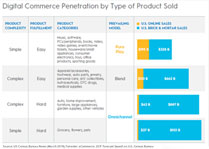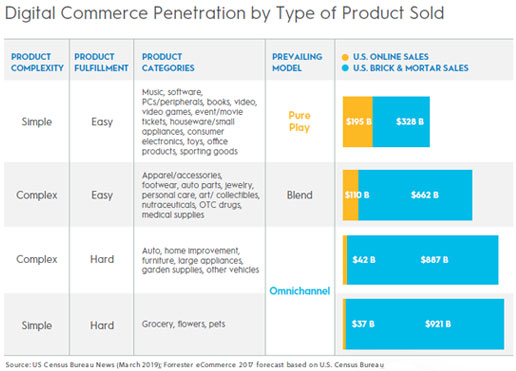 Carl Prindle, Founder & CEO
Carl Prindle, Founder & CEO To date, e-commerce has typically involved selling relatively simple, easy to fulfill products. Boston-based Blueport Commerce has built an omnichannel platform for the “rest of retail.”
Starting with Amazon’s launch as an online bookstore, the majority of online sales have involved products that are relatively easy to understand, catalog, and ship. These products play to the Internet’s strengths and don’t require the in-person shopping experience of a store.
But what about the rest of retail? More than 80 percent of U.S. retail involves products that are more complex and difficult to fulfill than those sold online today. Not coincidentally, a similar percentage of U.S. retail dollars are still spent in stores.
For retailers selling more complicated products, stores remain a valuable part of their customers’ shopping process. As a result, many retailers in these complex categories have been spared the “retail apocalypse.” Meanwhile, brick and mortar players in simpler, Internet-friendly categories—books, music, video, general merchandise, even department stores—have been decimated.
The Omnichannel Challenge for Retailers
Going forward, retailers in more complex categories face an equivalent “life or death” challenge. Consumers have come to expect effortless digital experiences in all aspects of their lives, including seamless shopping options. Today, it’s differentiated omnichannel experiences that determine retail’s winners and losers.
Developing such experiences is both critical and challenging for retailers. The technical requirements for omnichannel efforts are more complicated than simply opening an online store. Brick and mortar retailers face the additional complexity of synchronizing these digital efforts with their brick and mortar locations, legacy processes, and systems that weren’t built for digital commerce.
Moreover, retailers looking for help from typical e-commerce platforms may be disappointed. Even today’s best-known e-commerce platforms were built in the 1990s for a simpler form of e-commerce and don’t natively meet omnichannel retailers’ requirements and integration needs. Blueport, on the other hand, “offers retailers an omnichannel-first platform that turns their brick-and-mortar assets into an advantage, not a complication,” says Carl Prindle, the founder and CEO of Blueport Commerce.
Blueport: From E-commerce to Omnichannel
Blueport Commerce was spun out of Furniture.com—a furniture e-commerce site—in 2016. Today, some of the largest big-ticket retailers in North America build their websites on the Blueport platform, looking to provide better shopping experiences for their customers, and drive sales online and in their stores.
This evolution is the result of some hard-learned lessons. “During the dot-com bubble, Furniture.com was a B2C e-commerce site.
With time, we realized that for high-consideration purchases like furniture, we were fighting consumer preferences by selling only online. Without stores and salespeople to help shoppers select a product or the efficiency of local distribution, customer experiences were disappointing, and the economics of the business were worse. We had incredible shopper engagement, but everything else was a struggle. We knew there had to be a better way.”
With this insight, Furniture.com adopted a B2B business model, partnering with retailers to provide the physical infrastructure the original business lacked.

We offer retailers an omnichannel-first platform that turns their brick-and-mortar assets into an advantage, not a complication
Furniture.com was adapted to drive customers to local retailers who listed their inventory on Furniture.com. Stores helped conversion and local delivery helped improve both shoppers’ experiences and the business's bottom line.
Retailers, seeing success on Furniture.com, asked to leverage the Furniture.com platform to build their own sites, and the Blueport platform was born—one of the first Software-as-a- Service commerce platforms. Blueport’s customer list grew and retailers in similarly omnichannel categories like appliances, electronics, flooring and carpeting built sites on the Blueport platform. In 2016, the original Furniture.com website was sold and Blueport Commerce launched as an individual entity, solely focused on omnichannel solutions for retailers.
"With Blueport, retailers’ digital teams and their agencies get unprecedented flexibility in designing and launching new experiences. Using Blueport as a toolbox gives them unmatched speed to market, freeing them from re-solving the data, logic and integration challenges that can bog down these efforts"
Today, Blueport offers retailers a turnkey omnichannel solution. The platform enables retailers to build websites with best-in-class omnichannel features. It integrates with retailers’ legacy systems and offers a comprehensive suite of merchant tooling to supplement these systems.
The platform has also been rearchitected as one of the first Cloud-native commerce platforms - built as “containerized” microservices that both power a retailer’s website and can be leveraged by retailers across their digital experience efforts. It’s a comprehensive approach focused on removing omnichannel obstacles for retailers who otherwise have found digital transformation a challenge.
Omnichannel Features
Blueport’s platform is built specifically for the shopping experience requirements of omnichannel retail. Marrying digital and store experiences, native geolocation allows retailers to tune digital experiences to match a local store. The platform’s proprietary technology allows shoppers to move shopping carts between online and in-store as they consider their purchases. Salespeople are given tools to assist in omnichannel selling and can earn commissions for doing so.


The merchandise complexity that drives omnichannel behavior is supported by Blueport’s Product Information Management (PIM) system, which natively enables product customization, kitting, and complex product variations. A sophisticated discount and financing engine allows merchants to deploy the advanced promotional offers that are important in driving larger ticket purchases. Fulfillment channels ranging from in-store pick up to delivery via a retailer’s fleet are natively supported, bringing the delivery advantages of brick and mortar to online shoppers in a compelling, easy to use way.
“With these functionalities native to the platform, retailers can launch better omnichannel websites faster,” says Prindle. “Rather than struggling to get an e-commerce platform to do something it wasn’t meant to do, retailers can focus on designing the differentiated experiences for their shoppers.”
Merchant Tooling and Legacy System Integration
Recognizing that most legacy retail systems were built for store operations and not digital retail, the Blueport platform both integrates with and augments store systems, giving merchants a unified toolset to manage shopping experiences while remaining synchronized with store operations.
Available data is both read from and written to retailers’ legacy systems. Blueport merchant tools allow management of data that legacy systems don’t support, including rich product information, advanced pricing and promotion, shipping management, and customer segmentation. Online orders are placed based on real-time inventory availability and delivery schedules, with completed orders inserted into retailer’s legacy systems where they can be managed like any store order.
“Retailers understand the need for great digital experiences,” says Prindle, “but many fear they’d need to replace their core systems to offer those experiences to their shoppers. We’ve solved this with a leading integration layer and a merchant center that does everything their legacy systems can’t. Digital experience efforts retailers once found daunting are now immediately achievable.”
New Cloud-Native Architecture: Agility, Flexibility and Scalability
Blueport’s new Cloud-native architecture enables retailers to use these integrated merchant tools not just to run their websites but across their businesses.
The Blueport platform serves the data and logic that powers a retailer’s website as cloud-native microservices. Each microservice provides an atomic function such as providing the price or location of an item. This “building block” approach makes shopping experience design as fast and flexible as rearranging these tested, scalable services in new ways.
Retailers use Blueport API’s to leverage these microservices across their experience efforts. The same centrally managed, augmented information can power clienteling or Point of Sale in stores, selling on social media or marketplaces, and next-generation shopping platforms like AR, VR, Voice, and wearables. Retailers can also use these API’s to bring omnichannel features to their existing websites, or other digital experience platforms in so-called “headless” implementations.
“We offer unprecedented flexibility for retailer teams and their agencies in designing and launching new experiences. Using Blueport as a toolbox gives them unmatched speed to market, freeing them from re-solving data, logic and integration challenges that can bog down these efforts,” says Prindle. “Meanwhile, merchants get the ability to easily manage products, content and business rules in one place, using Blueport to centrally power their digital ecosystem while staying synchronized with their stores and legacy systems.”
The Future of Digital Retail
E-commerce has taken significant share in product categories that are relatively easy to understand and easy to ship. For other retail categories, there’s no more important challenge than bringing native brick and mortar advantages to digital shoppers.
With a comprehensive platform and powerful new architectural approach, Blueport bridges the gap between today’s shopping experience demands and retailers' stores, operations and legacy systems.
In doing so, the company is focused on the obstacles that have prevented some of retail’s largest segments to fully participate in the digital economy, unlocking the next wave of retail’s digital transformation— what Blueport calls “the rest of retail”.
 Carl Prindle, Founder & CEO To date, e-commerce has typically involved selling relatively simple, easy to fulfill products. Boston-based Blueport Commerce has built an omnichannel platform for the “rest of retail.”
Carl Prindle, Founder & CEO To date, e-commerce has typically involved selling relatively simple, easy to fulfill products. Boston-based Blueport Commerce has built an omnichannel platform for the “rest of retail.” 